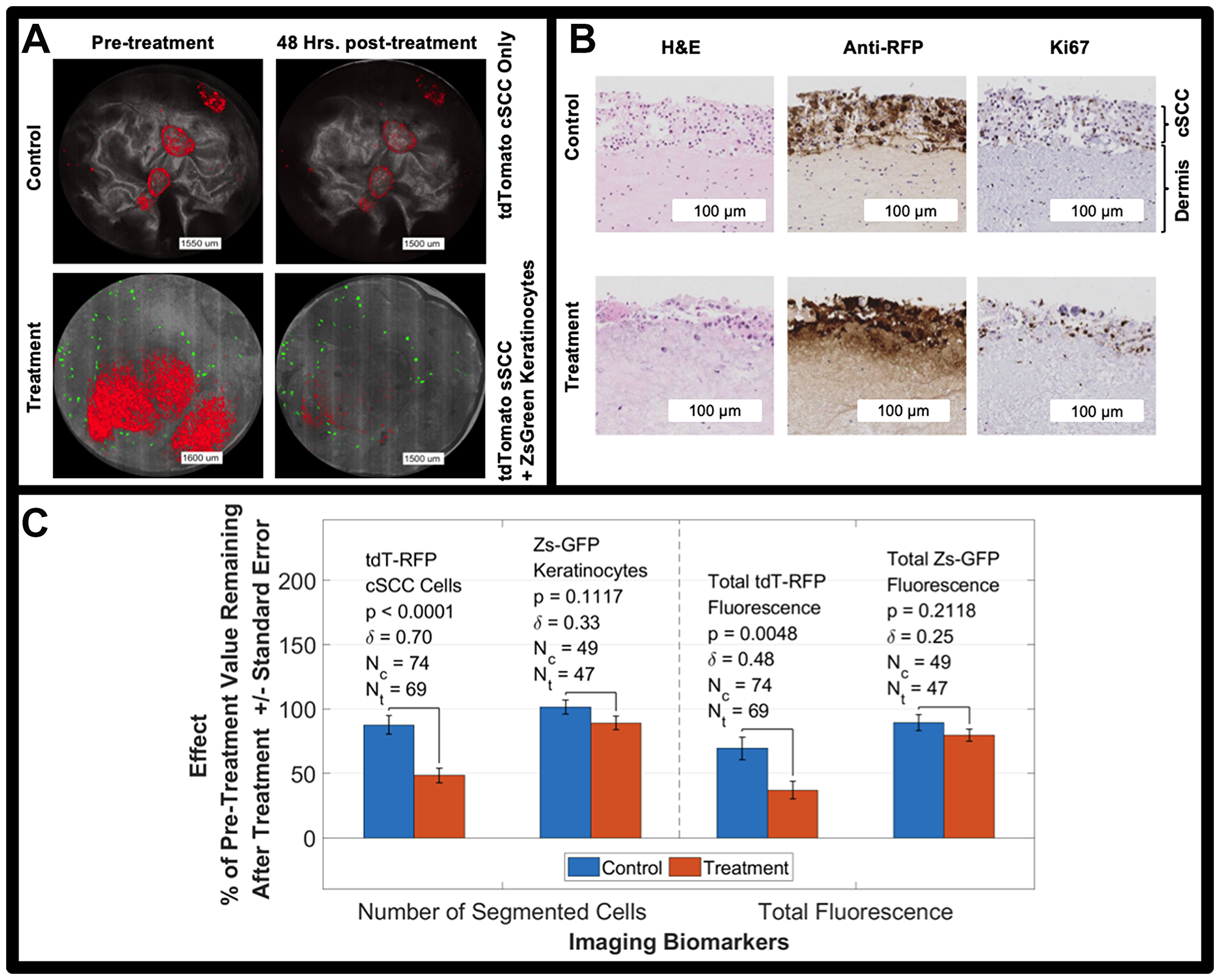The cover for issue 27 of Oncotarget features Figure 4, "(A) Bimodal imaging examples of control and treated tumors (red) before and after the treatment period," by Browning, et al. and reported that the authors developed a 3-dimensional bioprinted skin model of cutaneous squamous cell carcinoma (cSCC) tumors together with a microscopy assay to test chemotherapeutic effects in tissue.
Fluorescence-derived imaging biomarkers indicated that 50% of cancer cells were killed in the tissue after 1μM 5-Fluorouracil 48-hour treatment, compared to a baseline of 12% for untreated controls.
The imaging biomarkers also showed that normal keratinocytes were less affected by treatment than the untreated tissue, which had no significant killing effect.
Data showed that 5-Fluorouracil selectively killed cSCC cells more than keratinocytes.
The authors' 3DBPS assay platform provides the cellular-level measurement of cell viability and can be adapted to achieve non-destructive high-throughput screening in bio-fabricated tissues.
"The authors' 3DBPS assay platform provides the cellular-level measurement of cell viability and can be adapted to achieve non-destructive high-throughput screening in bio-fabricated tissues"
Dr. Daniel S. Gareau from The Laboratory for Investigative Dermatology at The Rockefeller University, New York said, "Global incidence of cSCC is 2.2 million people and accounts for most of the ~10,000 annual non-melanoma skin cancer deaths in the United States."
Drug discovery for small molecule therapies to treat locally advanced/inoperable or metastatic cSCC and other cancers can be accelerated using patient-specific, physiologically relevant models amenable to high-throughput screening.
Models should mimic the tumor microenvironment, given its influence on tumor progression and metastasis, and should reproduce in vivo tumor cell physiochemical signaling and mechanical cues from the surrounding tissue extracellular matrix.
Animal models may not be readily translatable to human cancer treatment, and three-dimensional tissue culture models offer a viable alternative for pre-clinical screening of small molecule therapeutics.
3D models using human-derived cell lines offer increased complexity and physiological fidelity compared with two-dimensional monocultures and have been developed for several cancer models, including melanoma, pancreatic cancer, and cervical cancer.

Figure 4: (A) Bimodal imaging examples of control and treated tumors (red) before and after the treatment period. cSCC tumors are red, reflectance is grayscale, and keratinocytes are green. All cSCC A431 cells are labeled with RFP while only 1% of keratinocytes are labeled with Zs-GFP resulting in sparsity of the green signal. (B) H&E, Ki67, and Anti-RFP antibody staining of untreated (control) tumor model and tumor model treated with 5FU for 48 hours. (C) 5FU treatment effect on tdT-RFP-labeled cSCC spheroids and Zs-GFP-labeled keratinocytes including p-value and effect size, δ. Two imaging biomarkers are shown, number of segmented objects and total fluorescence of the size-thresholded segmented objects. NOTE: the fluorescence in panel A is intentionally saturated for display.
In the disease model presented here, A431 cSCC spheroids were introduced into the tissue, and histopathology and cDNA microarray analysis was used to confirm the biological fidelity of the cancer model.
The authors' objective was to quantify the therapeutic efficacy of a standard of care treatment for a cSCC skin tissue model that recapitulates the microenvironment in which this cancer grows.
The Gareau Research Team concluded in their Oncotarget Research Paper that the model described provides a higher degree of clinical relevance because it enables the testing of chemotherapeutics against tumor cell growth in a tissue-specific context, thus capturing any potential interactions between the tumor and its microenvironment.
They envision that this model could be adopted in a “bedside” manner and applied to cells from cSCC patient tumor biopsies.
Sign up for free Altmetric alerts about this article
DOI - https://doi.org/10.18632/oncotarget.27570
Full text - https://www.oncotarget.com/article/27570/text/
Correspondence to - Daniel S. Gareau - [email protected].
Keywords - squamous cell carcinoma, screening, 3D printing, in vitro model, confocal microscopy
About Oncotarget
Oncotarget is a biweekly, peer-reviewed, open access biomedical journal covering research on all aspects of oncology.
To learn more about Oncotarget, please visit https://www.oncotarget.com or connect with:
SoundCloud - https://soundcloud.com/oncotarget
Facebook - https://www.facebook.com/Oncotarget/
Twitter - https://twitter.com/oncotarget
LinkedIn - https://www.linkedin.com/company/oncotarget
Pinterest - https://www.pinterest.com/oncotarget/
Reddit - https://www.reddit.com/user/Oncotarget/
Oncotarget is published by Impact Journals, LLC please visit http://www.ImpactJournals.com or connect with @ImpactJrnls
Media Contact
[email protected]
18009220957x105





